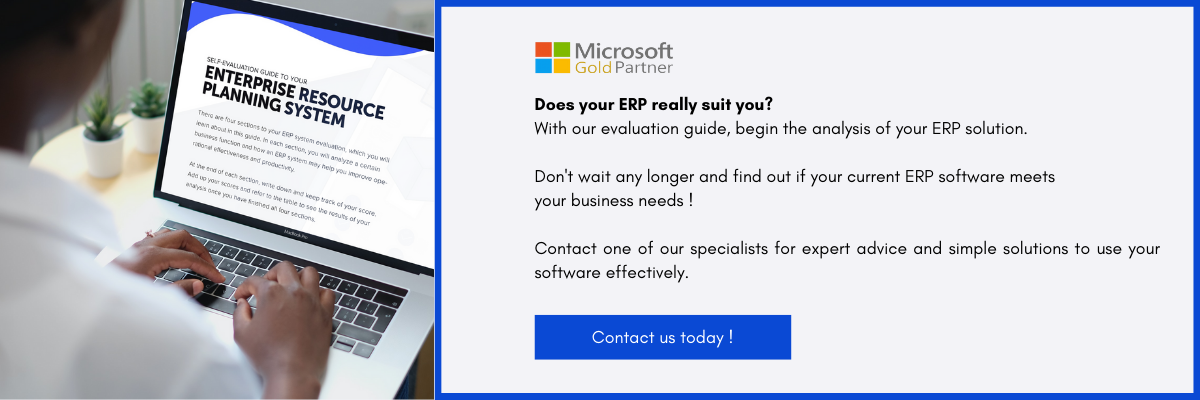We all know that life at work can be a messy tornado of stress and to-do lists to tackle that never stop growing. It’s one of the reasons why so many company choose to implement an ERP to help them in their daily operations.
However, if you’ve ever read about ERP project management and implementation methodology, you know how difficult it can be for companies to implement it. Despite the numerous benefits, many businesses can’t seem to succeed in their ERP implementation in the long run.
You will then be able to secure your ERP implementation success and go on with your life without stress, like say… mowing your lawn!
In this blog post, we will guide you through the steps on how to implement an ERP successfully, taking into account that you already have a qualified and trustworthy team.

9 steps to successfully implement your ERP
Step 1 for your ERP implementation : Clearly state your business needs
The first step consists of evaluating deeply and documenting your business challenges, workload, department needs and the global requirements of your reporting.
When comes the time to choose your ERP solution or even think about changing your software, it’s always wise to get an overview of the situation. This crucial step will allow you to determinate your goals, the scope of the project, but also everything you need in terms of an ERP solution. ERP implementation is an adventure that can have a huge return on investment, if you plan well!
Once the documentation is completed, spend some time to prioritizing and organizing your conclusions.
While any good consultant will conduct his own detailed evaluation of your needs, in any sale process, your efforts will act as a guide and will help you be more specific, efficient, and useful for everyone involved in the process.

Step 2 for your ERP implementation : Systematically evaluate every available ERP solutions
Once you are ready to start evaluating your options, call a colleague in the same industry or a trusty advisor to discuss their experience and recommendations on the matter. Their frank opinions will be invaluable to you. If you want to deepen your research, explore a list of consultants to meet.
Also let your employees express themselves on the subject because they will shed a whole new light on the specificities they need to perform.
Is it a waste of time? Never. Because your team is essential to your success and a lack on information on your part could lead you to some difficulties down the road of ERP implementation, or even a failure.
The benefits of ERP software for managing your business are real!
Plus, employees that cannot find a way to help can show resistance to the product.
So it is better to take time for this little meeting!

Step 3 for your ERP implementation : Name a leader of the ERP solution implementation
When an application is chosen, it’s essential for you to choose an in-house project manager.
This person will be the “proprietor” of the project plan, the point of contact for the entire advisor group, and the guardian who will assure the deployment of the project, and thus, making sure the budget and deadlines stay aligned with the global goals.
The in-house project manager is essential to the success of the project. They represent a non-negotiable requirement for you and your team.
Step 4 for your ERP implementation : Prepare a clear ERP implementation plan, but stay open to change
Once you have completed steps 1 through 3, you will have a solid base and a precise plan to install, configure, and optimize your system according to your work environment.
While project plans can change, keep in mind that the scope, the deadline, and the budget always need to be analysed and evaluated before making big changes.
Be careful, there are elements to consider before implementing an ERP within your organization!
Step 5 for your ERP implementation : Rethink your internal business process
ERP implementation is primarily to lighten your daily tasks, improve team cohesion, and increase productivity. So it’s the ideal time to rethink your internal business processes and make them more efficient.
Stop losing time, and maximize your investment!
.png)
Step 6 for your ERP implementation : Integrate your ERP to systems and customized developments
The integration with other applications or data sources, or customizing software to answer unique needs can considerably increase the efficiency and automation.
Like any other step of the implementation, evaluate the cost, take into account the delay caused by these new functions, and the benefits they provide.
Be careful, any customized development will have an impact on your ability to support the application in the future. Take your time to think about it!
Step 7 for your ERP implementation : Offer a complete training to your employees
Once the system is configured and the new processes are created, it’s crucial to take the necessary time to train your employees and users. Invest both in individual and group training to enable your employees to use the software at its maximum potential.
You have made an important investment that could have big return and to guarantee your success, the training is ES-SEN-TIAL.
Also plan a continuing training to teach all your employees how to use the software in the most optimal, efficient, and cost-effective way for your business. And this may sound a bit cliché, but this step will ensure that your team is happy and comfortable with the software.
It’s another important point to a successful ERP implementation!

Step 8 for your ERP implementation : Stay connected
After turning on the system, let the dust settle while the users get accustomed to it.
Maintain a list of new projects to complete to keep this development phase active, and to allow your company to be at the forefront of things.
But mainly, keep a close relationship with your advisor, and you should get the optimal value out of the system and its efficient function for years to come.
Step 9 for your ERP implementation : Constantly improve your procedure and ERP solution
Recognize that your system will only be as good as the investment you will continue to make in it.
We always recommend examining of the software at least once a year to help you identify the improvements you could make to it to get the maximum benefit from the latest technology developments like the updating of some parts, new plug-ins, more efficient procedures, or additional training for your team.
A long-term engagement with your ERP solution will allow you to maximize your investment and follow your successful road!
.png)
So successfully implementing an ERP? Not that complicated, eh?
The success of ERP implementation is pretty simple, after all. The most important thing, like many projects in business, is to keep the focus on the initial goal: maximize your investment in the ERP software.
Keep in mind that your needs and the reasons behind the choice of a specific ERP solution, and stay engaged to make it better throughout the process.
Our 4 best tips to guide you through successfully implementing an ERP
- The importance of the managers engagement in the project
- The communication between the management, employees, consultant, and the project manager
- The presence of a project manager almost constantly on the field while implementing
- A project manager with both professional and personal training
Are you planning an ERP implementation in the next few months? Meet today with one of our experts to start in the right direction.

Liked what you just read? Sharing is caring.

May 27, 2025 by Kooldeep Sahye by Kooldeep Sahye Marketing Specialist
Fuelled by a passion for everything that has to do with search engine optimization, keywords and optimization of content. And an avid copywriter who thrives on storytelling and impactful content.
